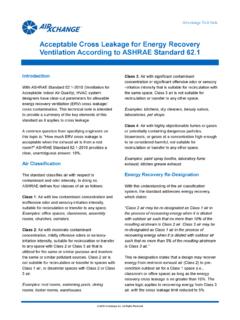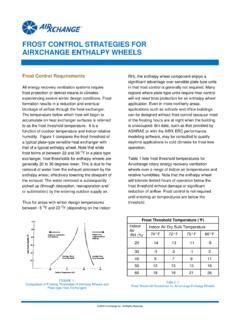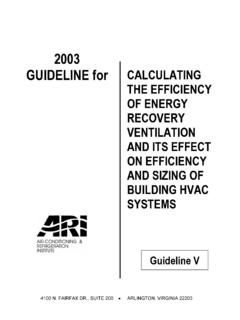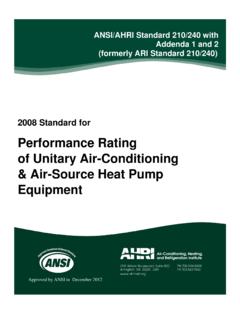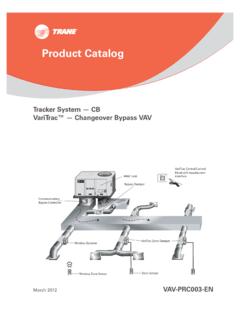Transcription of Matching the Sensible Heat Ratio of Air Conditioning ...
1 TIAX LLCA corn Park Cambridge, MA 02140-2390 USA +1 617 498 the Sensible heat Ratio of Air ConditioningEquipment with the Building Load SHRF inal Report to: AirxchangeNovember 12, 2003 Report prepared by: TIAX LLCR eference D5186 Notice:This report was commissioned by Airxchange on terms specifically limiting TIAX s liability. Our conclusionsare the results of the exercise of our best professional judgement, based in part upon materials andinformation provided to us by Airxchange and others. Use of this report by any third party for whateverpurpose should not, and does not, absolve such third party from using due diligence in verifying thereport s use which a third party makes of this document, or any reliance on it, or decisions to be made basedon it, are the responsibility of such third party.
2 TIAX accepts no duty of care or liability of any kindwhatsoever to any such third party, and no responsibility for damages, if any, suffered by any third party asa result of decisions made, or not made, or actions taken, or not taken, based on this of ContentsTABLE OF ILIST OF TABLES ..IILIST OF FIGURES .. THE MYTH OF THE DECLINING LATENT CAPACITY OF unitary air BUILDING HUMIDITY CONTROL PROBLEMS ARE NOT A THE Ratio OF Sensible AND LATENT COOLING LOADS IN BUILDINGS HAS OPTIONS FOR INCREASING THE LATENT EVOLVING Sensible heat Ratio OF COMMERCIAL Sensible AND LATENT COOLING CHANGING BUILDING ENERGY EFFICIENCY AND VENTILATION STANDARDS ASHRAESTANDARD AND ASHRAE STANDARD 62 .. Envelope .. and BUILDING COOLING LOAD CALCULATIONS FOR A RANGE OF CLIMATE Evolution of Envelope and Lighting Specifications Over Time.
3 SYSTEM Sensible heat Ratio OF COMBINATIONS OF HVAC SYSTEM SHR GENERAL SYSTEM SHR unitary air CONDITIONER COMBINED WITH AN AIR TO AIR ENTHALPYRECOVERY Calculation of Combined SHR for Unitary and ERV .. Example the Example Office Building of Section Infiltration .. ERV Latent Effectiveness < ERV Sensible Effectiveness .. of Unitary + ERV SHRs for the Examples in Section .. OF KEY FINDINGS .. 6-1iiList of TablesTable 2-1: Changing Minimum Outdoor Make-Up Air Ventilation Rates Per ASHRAES tandard 62 .. 2-7 Table 2-2: Required CFM/ft2, Based on Estimated Maximum Occupancy andRequired CFM/Person .. 2-7 Table 2-3: Weighted Average Ventilation per Floorspace Required for Office 2-4: Input Values of the Envelope .. 2-11 Table 2-5: Design Conditions .. 2-11 Table 3-1: Combined SHR Calculation .. 3-4 Table 3-2: Comparison of the Building Cooling Load SHR with the Combined Unitary+ ERV SHR in Miami Climatic Conditions.
4 3-5 Table 3-3: Comparison of the Building Cooling Load SHR with the Combined Unitary+ ERV SHR in Boston Climatic 3-5 Table 3-4: Sensitivity Analysis Impact of Infiltration (at Air Changes/Hour) .. 3-7 Table 3-5: Sensitivity Analysis: latent = sens (Unitary SHR = ) .. 3-8 Table 3-6: Ventilation Portion of Design Load, Corresponding ERV Net RecoveryCapacity at = 3-8 Table 3-7: Design Load and Unitary Capacity Net of the ERV NRC .. 3-9 Table 3-8: Combined SHR (Unitary SHR = ).. 3-9iiiList of FiguresFigure 1-1: Airstream Temperature Passing Through Evaporator 1-2 Figure 1-2: Indoor RH vs. Building Cooling Load SHR with Conventional Unitary AirConditioning Equipment .. 1-5 Figure 2-1: ASHRAE Maximum Wall Assembly U Values, Over Time .. 2-4 Figure 2-2: ASHRAE Maximum Roof "U" Values Over Time .. 2-5 Figure 2-3: ASHRAE Maximum Solar heat Gain Coefficient Over Time.
5 2-5 Figure 2-4: ASHRAE Maximum Lighting Power Density (for Office Space) andEstimated Office Equipment Power Density .. 2-6 Figure 2-5: Model Office Building 2-8 Figure 2-6: Area Plot of Basic Constituents of the Sensible and Latent Cooling Loads Miami / Latent Design Day / 1st Floor North Zone / 1981-1989 .. 2-10 Figure 2-7: Area Plot of Basic Constituents of the Sensible and Latent Cooling Loads Miami / Latent Design Day / 1st Floor North Zone / 1989-1999 .. 2-10 Figure 2-8: Building Load SHR from 1975 Present, at Sensible Design Condition(High Outdoor Temperature) .. 2-12 Figure 2-9: Building Load SHR from 1975 Present, at Latent Design Condition (HighOutdoor Humidity).. 2-12 Figure 2-10: Building Load SHR from 1975 Present, at Shoulder or Part LoadCondition (High Outdoor Humidity, Moderate Temperature ) .. 2-13 Figure 3-1: unitary air Conditioner with a Factory Integrated AAHX.
6 3-2 Figure 3-2: Comparison of the Building Cooling Load SHR with the Combined Unitary+ ERV SHR in Miami and Boston Climatic Conditions .. 3-6 Figure 3-3: Impact of Infiltration on the Match of the Building Cooling Load SHR withthe Combined Unitary + ERV SHR (at the Latent Design Condition).. 3-7E-1 Executive SummaryIn recent years, an increasing number of buildings and their occupants have experiencedserious moisture problems including so-called sick building syndrome , mold growth,and occupant discomfort due to high humidity. These problems arise from both poorinterior humidity control and liquid water sources such as plumbing leaks and rain waterleakage. Moisture and mold problems can cause serious health problems among theoccupants and reduce productivity. In extreme cases, buildings have been rendereduninhabitable. The financial consequences of these situations can be substantial and arereflected in rapidly escalating liability insurance rates.
7 These impacts have been widelyreported and documented by research and in the humidity control is often attributed to the inability of conventional unitary airconditioners to handle the moisture loads. A common conception holds that theincreased efficiency of modern air Conditioning equipment has resulted in reduced latent(moisture removal) Myth of the Declining Latent Cooling Capacity of unitary air ConditionersWhen air Conditioning equipment cools air, it reduces the temperature of the air( Sensible cooling) and it reduces the moisture content of the air (latent cooling) bycausing a portion of the water vapor in the air to condense into liquid water. Thedehumidification effectiveness of air Conditioning equipment is commonly characterizedby the Sensible heat Ratio (SHR), which is the Ratio of the Sensible cooling capacity tothe total ( Sensible + latent) cooling capacity.
8 Reducing the SHR increases the portion ofthe total cooling capacity that is providing has become a matter of common wisdom that increases in the energy efficiencyratio (EER) of unitary air conditioners that have occurred since the early 1980 s havebeen accompanied by a decrease in the latent cooling capacity as a fraction of the totalcooling capacity ( , increased SHR). The wisdom explains that among the ways thatefficiency is increased, increasing the evaporator surface area results in a higherevaporator temperature and therefore, less moisture removal the real world of commercially available equipment, no such direct relationshipexists. ARI [Amrane, 2003] has recently conducted an extensive review of therelationship between EER and SHR, both for current equipment and earlier eraequipment going back to the 1970s. The consistent finding is that the SHR of individualunitary air conditioner models has varied between and at all EER levels, from1970 to the present, with no statistically significant correlation between either the EERand the SHR or between the year of manufacture and the Ratio of Sensible and Latent Cooling Loads in Buildings Has ChangedWhile the SHR of unitary air Conditioning equipment has not changed, building loadshave changed substantially.
9 The energy efficiency improvement measures better walland roof insulation, reduced window U-values, increased solar shading, more energy-efficient lighting that have been driven by ASHRAE Standard have almostexclusively reduced Sensible cooling loads. Latent cooling loads, which for mostcommercial buildings are primarily due to ventilation, infiltration, and occupants, havenot changed effect for most buildings constructed or thoroughly remodeled since 1990 is to raisethe latent cooling load relative to the Sensible cooling load at all conditions. At typicalcooling design conditions, outdoor humidity levels and the consequent latent loading isquite high, while both envelope and internal Sensible loads have been reduced,compared to buildings constructed prior to 1990. Conventional unitary air conditioningtends to satisfy the Sensible load well before the latent load is met, with the result thatthe steady state indoor relative humidity (RH) increases from the desired range around50% to around 70% (uncomfortable and supportive of mold growth).
10 At moderateoutdoor temperatures, 65oF to 70oF, with high outdoor humidity, the low Sensible loadresults in unitary air conditioners cycling on-off frequently with short on cycles. Duringthe off cycle, moisture on the coil can re-evaporate, causing further deterioration of thenet latent capacity and driving up the indoor Impact of Changing Building Ventilation and Efficiency StandardsOver the past 30 years, two trends have affected commercial building cooling loads andthe Ratio of latent to Sensible load. The first of these is a drive to improve the energyefficiency of the US economy, reflected in tightened efficiency standards forautomobiles, appliances and buildings. The second trend has been the recognition of theneed for minimum levels of outdoor ventilation air to maintain reasonably healthyconditions inside buildings. ASHRAE standards 62 and were created to setminimum standards for building ventilation and for energy related aspects of buildingdesign, respectively.
